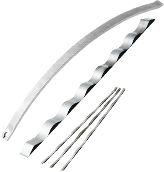Question 山田です 2003/11/5(Wed) 17:49
Question 1, I think it depends on the material, but in general, how does the spring coefficient of a metal material change with fatigue?
Question 2, what is the difference between spring constant and elastic coefficient? They seem similar to me.
Answer Tokai Spring 2003/11/7(Fri) 16:32
Question ①
The fatigue characteristics of a material are usually expressed in the form of a so-called S-N curve, which is the magnitude of the stress that is repeatedly applied and the number of cycles to failure (fatigue life).
The lower the stress, the greater the number of cycles to failure is, but for steel, etc., there is a limit stress and fatigue limit at which fatigue failure does not occur below a certain stress.
※An example of S-N curve is attached for reference.
Question ②
・“Spring constant”: The force or moment required to give a deformation (deflection) per unit to a spring.
Example: Spring constant = 10 N/mm → The force required to bend 1 mm is 10 N.
・“Elastic coefficient”: When a force is applied to a material, it stretches in proportion to the force.
The rate of expansion depends on the material, but has a constant value.
For example, in the case of steel, it will be approximately 21000 kg/mm2, and in the case of copper it will be approximately 12000 kg/mm2.
It shows that steel is less stretchable than copper when the same force is applied.
That is, as a mechanical part, when an external force is applied, it bends, but the ratio is called the “spring constant”, and the “spring constant” is determined by the “elastic coefficient” of the material and the shape and dimensions of the material.
Answer Anonymous 2017/5/9(Tue) 9:15
How will the spring constant change if the coil spring is rusted?
I thought that the metal would harden due to rust, making it harder to shrink and increasing the spring constant. Is that correct?
Answer Tokai Spring 2017/5/9(Tue) 10:14
Spring Newbie, I think that the change in spring constant due to rust is not considered within the usage limit of springs.
However, if the rust is severe, the spring constant may change due to hardening or reduction of the material diameter.
※Usually, it is not used in a rusty state.
If you find rust, we recommend replacing it with a rust-free spring, as the above causes the possibility of premature breakage!
Thanking you for you inquiry!!
Answer Kinno Chi 2021/9/8(Wed) 2:28
Hi,
I am helping my customer to solve a problem. They have a big gate maybe around 14ft wide 8 ft high I estimate about 1000lb and it will bend the pole foundation. and the ground is not on same level, about 4 -6 in difference. they originally have a caster mount on the edge of the gate, but got damaged. plan to have a long coil spring on the caster, so it can take some load of the gate, and it can work even on different high.
Answer Tokai Spring 2021/9/8(Wed) 14:21
Dear Kinno,
Thank you for your question. Could you please send us more information about the gate and the casters (photos, illustrations)?
We look forward to hearing from you soon.
Best regards,
Tokai Spring’s Support Team
We are happy to answer any inquiries regarding technology, specifications, materials, etc. Please feel free to ask.

















